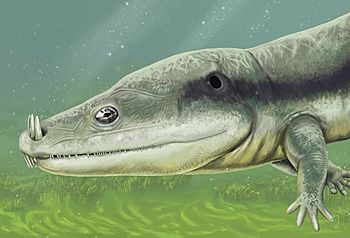Microposaurus
Quick facts for kids Microposaurus |
|
|---|---|
 |
|
| Life restoration of Microposaurus averyi | |
| Scientific classification |
|
| Kingdom: | Animalia |
| Phylum: | Chordata |
| Order: | †Temnospondyli |
| Suborder: | †Stereospondyli |
| Family: | †Trematosauridae |
| Subfamily: | †Trematosaurinae |
| Genus: | †Microposaurus Haughton, 1925 |
| Species | |
|
|
Microposaurus (which means "small eyed lizard") was an ancient animal that lived a very long time ago. It was a type of temnospondyl, which were like early amphibians. Microposaurus lived in the water and had a short snout.
Fossils of Microposaurus have been found in South Africa and Australia. These fossils show that it lived during the Middle Triassic period, about 247 to 242 million years ago.
Contents
Discovering Microposaurus
The First Find: M. casei
The very first Microposaurus fossil was found in 1923 by Dr. E. C. Case. He discovered it in South Africa, in an area called the Cynognathus zone. The fossil was a skull, found in soft, dark-green mudstone. This type of rock suggests that Microposaurus lived in or near water, like an amphibian.
This first species was named Microposaurus casei after Dr. Case. The skull was a bit squashed and covered in a hard material, which made it difficult to study at first. Because of this, some early ideas about its features turned out to be wrong.
A New Species: M. averyi
Many years later, another type of Microposaurus was found. In Australia, Steven Averyi discovered a new species during an expedition. This species was named Microposaurus averyi.
Even though M. averyi was found far away in Australia, the environment where it lived was similar to South Africa. It was a marine (ocean) area with silty claystone, which also suggests an amphibian lifestyle.
What Microposaurus Looked Like
Microposaurus was a type of amphibian that lived mostly in water. It was usually about 1 to 2 meters (3 to 6 feet) long.
Its Skull and Snout
The skull of Microposaurus was narrow and long, shaped a bit like a wedge. Its snout was short and rounded at the tip. The nostrils were close together and set a bit further back on the snout.
A unique feature of Microposaurus was that it had large tusks on its lower jaw. These tusks were so big that they poked into the openings of its nostrils! Its eyes were oval-shaped and located towards the front of its skull.
Its Teeth
Microposaurus had very special teeth. The teeth along the edges of its jaw were curved inwards. It also had fewer teeth on the roof of its mouth. The large tusks in its upper jaw were very impressive, some reaching about 50mm (2 inches) tall. These teeth and tusks helped it catch its food.
Differences Between Species
While M. casei and M. averyi were similar, there were a few differences. For example, M. averyi had larger external nostrils that were placed more towards the front of its snout.
Where and How Microposaurus Lived
Microposaurus lived during the Triassic period, a time when the Earth was changing a lot. After a big extinction event, many new rivers and water environments appeared, which was perfect for these water-loving animals.
Diet
Because Microposaurus lived in water, scientists believe it ate fish and other small water creatures. Most trematosaurids, the group Microposaurus belonged to, were carnivores (meat-eaters) and lived in marine (ocean) environments at some point in their lives.
Spreading Out
Microposaurus and its relatives were found all over the world. This wide spread might be because they could live in water with different salt levels, from near the coast to river deltas. They were also very good at surviving tough environmental changes, which helped them spread to new places like South America and even Jordan.
See also
 In Spanish: Microposaurus para niños
In Spanish: Microposaurus para niños

